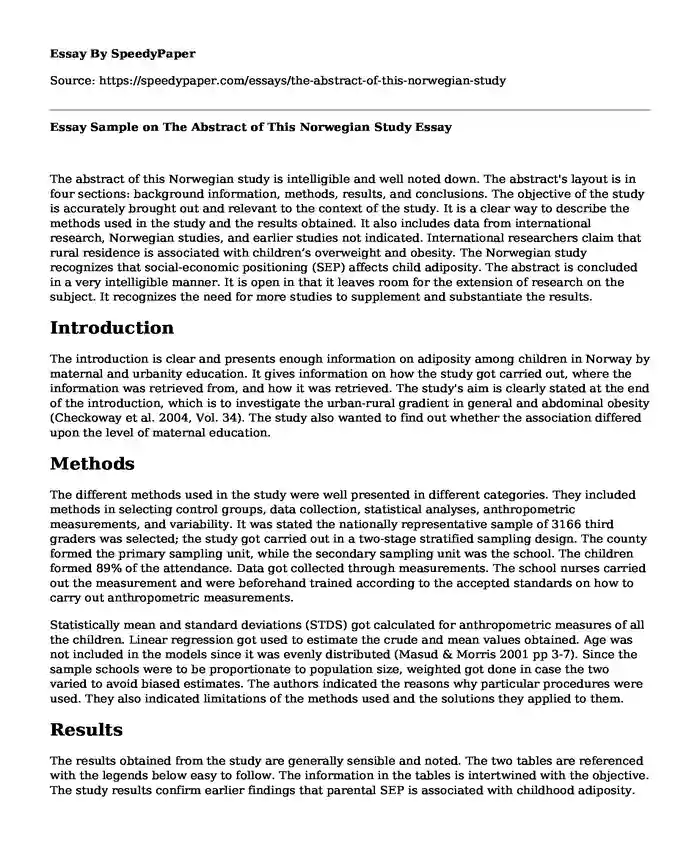
| Type of paper: | Essay |
| Categories: | Diet Case study Community health Essays by wordcount |
| Pages: | 3 |
| Wordcount: | 762 words |
The abstract of this Norwegian study is intelligible and well noted down. The abstract's layout is in four sections: background information, methods, results, and conclusions. The objective of the study is accurately brought out and relevant to the context of the study. It is a clear way to describe the methods used in the study and the results obtained. It also includes data from international research, Norwegian studies, and earlier studies not indicated. International researchers claim that rural residence is associated with children’s overweight and obesity. The Norwegian study recognizes that social-economic positioning (SEP) affects child adiposity. The abstract is concluded in a very intelligible manner. It is open in that it leaves room for the extension of research on the subject. It recognizes the need for more studies to supplement and substantiate the results.
Introduction
The introduction is clear and presents enough information on adiposity among children in Norway by maternal and urbanity education. It gives information on how the study got carried out, where the information was retrieved from, and how it was retrieved. The study's aim is clearly stated at the end of the introduction, which is to investigate the urban-rural gradient in general and abdominal obesity (Checkoway et al. 2004, Vol. 34). The study also wanted to find out whether the association differed upon the level of maternal education.
Methods
The different methods used in the study were well presented in different categories. They included methods in selecting control groups, data collection, statistical analyses, anthropometric measurements, and variability. It was stated the nationally representative sample of 3166 third graders was selected; the study got carried out in a two-stage stratified sampling design. The county formed the primary sampling unit, while the secondary sampling unit was the school. The children formed 89% of the attendance. Data got collected through measurements. The school nurses carried out the measurement and were beforehand trained according to the accepted standards on how to carry out anthropometric measurements.
Statistically mean and standard deviations (STDS) got calculated for anthropometric measures of all the children. Linear regression got used to estimate the crude and mean values obtained. Age was not included in the models since it was evenly distributed (Masud & Morris 2001 pp 3-7). Since the sample schools were to be proportionate to population size, weighted got done in case the two varied to avoid biased estimates. The authors indicated the reasons why particular procedures were used. They also indicated limitations of the methods used and the solutions they applied to them.
Results
The results obtained from the study are generally sensible and noted. The two tables are referenced with the legends below easy to follow. The information in the tables is intertwined with the objective. The study results confirm earlier findings that parental SEP is associated with childhood adiposity. The area of maternal education and residence affects child adiposity. For instance, the unadjusted analysis showed that the mean WC and BMI increased from urban to rural. The statistical data in the study proves to be significant, as noted and discussed.
Discussion
The study's objective was met since the authors found an urban, rural gradient in child adiposity. It was also noted from high to low maternal education adiposity increased. Children with mothers who had low education levels in rural areas showed a significant increase in mean WC and BMI values. The results obtained in this study are in accordance with other studies that have been done in the past. The study mentions its strengths and weaknesses. The sampling methodologies ensured a nationally represented population while the systematic data collection of anthropometric data was used. The only limitation was that most of the Norwegian population was educated. The study concludes that other countries can use the same mechanism to research the same exempting the distribution of education. This is because some countries may have high maternal education levels than others.
References
Adami, H.O., Hunter, D.J., and Trichopoulos, D. eds., 2008. Textbook of cancer epidemiology. Oxford University Press, USA.
Berkman, L.F., Kawachi, I. and Glymour, M.M. eds., 2014. Social epidemiology. Oxford University Press.
Checkoway, H., Pearce, N., and Kriebel, D., 2004. Research methods in occupational epidemiology (Vol. 34). Monographs in Epidemiology and.
Gregg, M.B. ed., 2002. Field epidemiology. Oxford University Press, USA.
John, M.L., 2001. A dictionary of epidemiology. Oxford university press
MacMahon, B., and Pugh, T.F., 1970. Epidemiology: principles and methods. Epidemiology: principles and methods.
Masud, T., and Morris, R.O., 2001. Epidemiology of falls. Age and aging, 30(suppl_4), pp.3-7.
Rothman, K.J., Greenland, S., and Lash, T.L. eds., 2008. Modern epidemiology. Lippincott Williams & Wilkins.
Cite this page
Essay Sample on The Abstract of This Norwegian Study. (2023, Sep 28). Retrieved from https://speedypaper.net/essays/the-abstract-of-this-norwegian-study
Request Removal
If you are the original author of this essay and no longer wish to have it published on the SpeedyPaper website, please click below to request its removal:
- Free Essay Example on Customer Service in a Hotel
- Volunteering Essay Example for Free Use
- Free Essay on Negotiation Experiences
- Response Paper #3 The Nether by Jennifer Haley.
- Free Paper Example: Audit of Secondo SA and Its Consolidation Report
- For the idea to be validated, proper research which agrees with scientific reasoning should be conducted. Exercise has an effective role in the development of lungs. As people exercise, breathing process increases. At times, there is deep inhaling and exhaling. This is done to compensate for oxygen debt.
- Prescription Drug Monitoring Programs - Essay Example
Popular categories




